One of the many reasons I love this dish is because I can enjoy it year-round. In the winter and fall, it is comforting and medicinal. In the spring and summer, it replenishes lost minerals. For that reason, this soup is very versatile - no matter the season, you can find vegetables that work. It also works well as an "empty the fridge" soup for any vegetables that haven't gotten used up during the course of the week. (If you participate in CSA or farm share programs, you know exactly what I mean.)
Jump to Recipe
It's excellent served with a variety of side dishes, such as kimchi (either made from cabbage or radishes) as well as steamed rice.
What's in it?
There are just a few must-haves and unfortunately no good substitutions. So get out there and find an Asian grocery store, and for those of you who don't live near a good Asian grocer, you can typically order them online.
Korean red pepper paste (gochujang) - This is a spicy, savory, fermented product that should ideally only have 3 ingredients: red peppers, rice, and salt. Today lots of companies add high fructose corn syrup, maltose, wheat, MSG, and other stuff we don't want. Look for a paste in a glass container and check the ingredients. Some Asian grocery stores have their own homemade versions sold in the refrigerated section that can work.
When you get your paste, take a tiny taste of it, as different brands have different heat levels. The heat level can even vary within brands at certain times of the year. Tasting it before you cook with it will allow you to adjust the heat levels of your final dish.
Korean red pepper flakes (gochugaru) - Look for a brand made in Korea and store it in the freezer between uses. Please avoid the temptation to replace gochugaru with cayenne powder, Mexican chile powders, or even Thai chile powder. They are all very different flavors and aren't interchangeable in this recipe.
Fish sauce - I'm sure most of you know this ingredient very well. It's a staple of Southeast Asian cooking. You should look for a brand that has simple ingredients. Anchovy, salt, and sugar are the most a fish sauce should have. The small amount of sugar in the Thai fish sauce is of no concern since it's fermented, so the live culture gobbles most of that up.

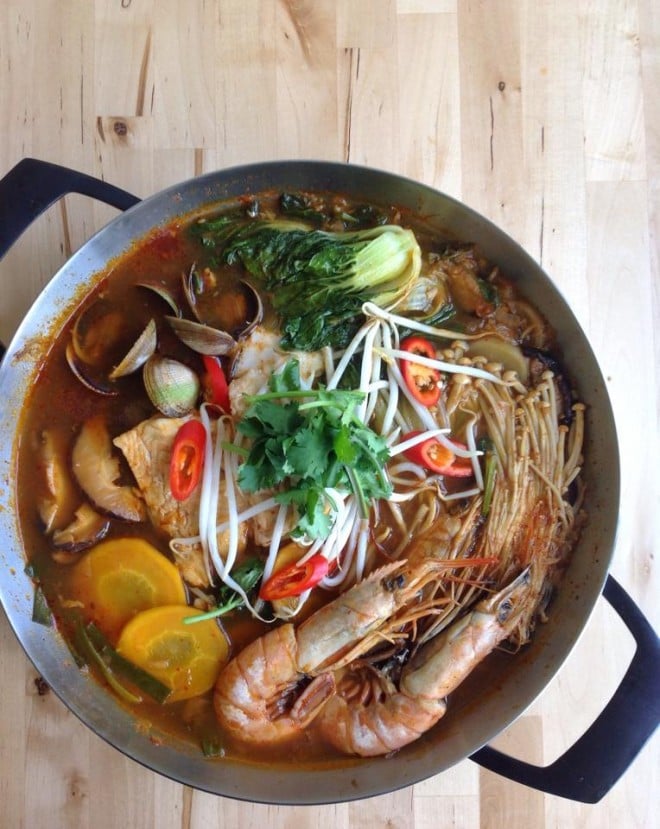
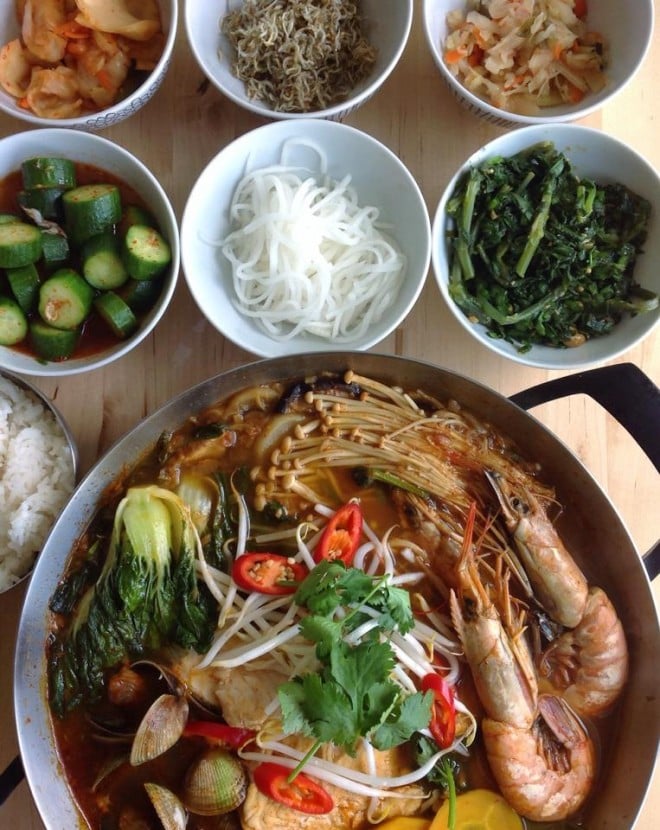
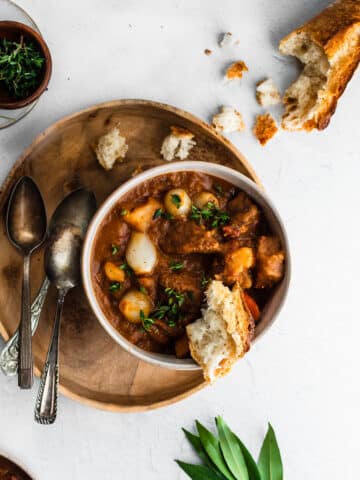
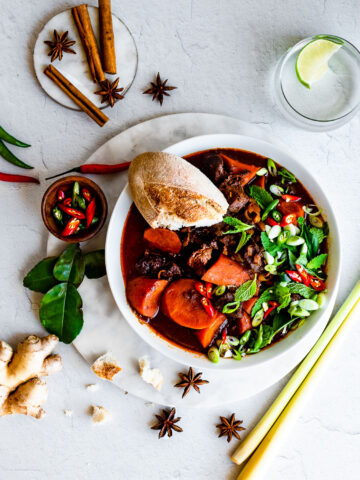

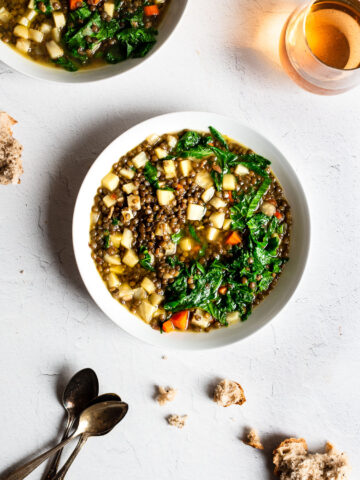
Sopretious says
What substitutions do you suggest for the lard, fish stock, fish sauce, etc that would make this a good vegetarian (no fish, no poultry, no meat) dish?
Jenny says
That would be an entirely different recipe.
Viola says
Any advice about how to source sustainable shrimp? I almost never buy it because I have trouble finding any trustworthy sources.
Kate says
gochujang is made with fermented soybeans in addition to red peppers, rice and salt. You can make your own: http://www.maangchi.com/recipe/gochujang
Sarah Atshan says
Hey all, thanks for your wonderful feedback on my recipe!
I wanted to leave a link to the recipe I used to make the seafood broth for this soup for those who are interested:
Korean Seafood Broth Recipe - Nutrientsyoufools.com
Thanks!
-Sarah
karen says
Ah...my mouth is watery, just looking at the photo. One of my all time favorite dishes my mom makes!
But since some of us are allergic to shellfish, she only uses salmon and other types of fish. Salmon has healthy Omega-3 so it's win win if you can't eat shellfish.
I don't mean to add uninvited comments but since I grew up eating this all my life, I'd just like to add a few suggestions.
Broth - you can make broth with Kombu or just use filtered water like my mom does since the fish and seafood you are using will make the broth while making the stew.
Lard - traditional Korean seafood stew does not use lard, even if its healthy, since Salmon creates a lot of good fat.
Honey - you can omit honey since onions makes the broth sweet enough.
Cilantro - I love cilantro but it's not used in Korean cooking. If you want to make it real authentic and you can find it, add "Crown Daisy" ( sukgat) or Chrysanthemum_coronarium at the very end, before serving. It almost tastes like cilantro but not quite.
But even if you don't use these tips, this recipe is as close to the authentic Korean Seafood Stew as it gets! Great job!
Molly says
What can u use instead of lard? Is there a healthier option?
Jenny says
Lard is healthy, Molly. It is comprised primarily of monounsaturated fat (the same heart-healthy fat found in olive oil and avocado), and is extraordinarily rich in vitamin d.
Molly says
What is the korean name for this soup?
Sarah Atshan says
Hi Molly, it's called: Haemultang
Doug says
Haemul jigae! Love this stuff! When I was in Korea several years ago, I had a fantastic bowl of this, and I encountered a new ingredient for the first time. It's hard and chewy - like a piece of tire - whitish in color, and roughly the size of a marble. I asked the waitress what it was called, and she replied "mee-da-da". I imagine it would be spelled 미다다. I asked what it actually was, and she got a friend who spoke better english, and the answer was, "It is of the sea." FAAANTASTIC. Fast forward a few years, and I'm at an H-mart in Annandale, VA. Sure enough, in the frozen section, there's a bag labeled "미다다". I flipped the bag over and read everything I could. I still have NO IDEA what this stuff is! Very frustrating! Does anybody have a guess what it might be? 7 years, and I still don't have an answer. As hard and chewy as it was, I'm guessing it's just mean to flavor the stew, rather than be eaten. Not sure, though.
Sarah Atshan says
Hey Doug, That's so curious! I've heard of dried sea worms as the secret ingredient for pho...and the use of dried scallops in Chinese dishes, but not what you mention. We need to do some serious research. Hopefully someone knows!
Sarah Atshan says
A quick google and I came across some folks using: warty sea squirt and sea pineapple in their fish stews...so maybe it was something like that?
ju says
Hi, Came across this wonderful page. It's mea-du-duk -[미더덕] stalked sea squirt - wash well in water and include in seafood soup. 🙂 It can get very hot so don't let it all burst in your mouth without cooling it. Also, you can use beef bone stalk for soup base and essentially use similar vegi but include beef meat instead for those who cannot eat seafood.
Sarah Atshan says
Hi Ju! Thanks so much for the mystery ingredient confirmation.
I love the beef version as well. 🙂
Hilary Moshman says
What is an acceptable substitute for the fish broth? Chicken stock or water?
Jenny says
What I would do (and I'm not the recipe devleoper on this one), would be to take the heads and/or shells from the shrimp and boil them in chicken stock to make the broth. Or I'd use Japanese fish stock (dashi) which is super easy to make at home as it just uses bonito flakes which are shelf-stable and found in many health food store, asian markets and online.
Sarah Atshan says
Hi Hilary- Jenny made some great suggestions.
For my fish broth I like to use the fish carcass with the head (gills removed), shrimp shells and heads (crushed in my blender with a lil water) and a handful of dried baby anchovies. I also include vegetable scraps I have saved up in my freezer. That can be anything from onion and carrot trimming to bits of celery.
Hope that helps! Thanks for your comment.
Sarah Atshan says
Ah! I forgot to mention I also add a piece of kelp. Thanks again
-Sarah
karen says
Oh my goodness. You did a great job with this stew Sarah. We make this stew quite often and I commend you for making it! It's not easy and it looks like you did a great job. To answer Hilary's question about the broth...You don't have to use fish stock. If you are already using a variety of seafood as pictured. When you make the stew, you are creating the stock with all the ingredients. When we make it, in addition to the seafood pictured here, we always add two fish heads....preferably, salmon! So just use filtered water and you'll get automatic fish stock at the end! Now I'm hungry. (We also use crown daisy - green veggies - when in season)
caligirl says
i agree about not needing any pre-made seafood stock. a thing i like to do is roasted shrimp shells in the oven for a bit til fragrant, add them to filtered water and slowly simmer for about a half hour then dish them out with a slotted spoon. takes a bit more time for yout prep, but the end result is a richer, earthier broth, in my opinion.
Leslie says
This is fantastic! It'll take me a while to get all the ingredients to make this..but this looks like a stew for a special occasion. I'll have to make this for my parents some time. Thank you
Sarah Atshan says
Thanks Leslie! You should get yourself to an Asian grocery store! But it is definitely a great dish for a special occasion. I hope you enjoy.
Deitan says
This looks like a fabulous soup! Question though : if one doesn't eat shellfish what would be the optimal substitute protein? Thanks!
Sarah Atshan says
Hi Deitan,
Thank you! If you aren't able to do shellfish you can just stick to fish. Maybe use a couple of different species for variety. You will still have a delicious soup.
Susan says
The product you link to with the , "You can find Korean red pepper paste here," link contains both corn syrup and wheat. It seems incongruous to link to that after your statement about not going out to eat because we encounter the same product there.
Jenny says
I'm seeing, "Rice (25%, produced in Korea), Red pepper powder (10.1%, produced in Soon-Chang, Korea), Jochung (rice malt syrup, rice produced in Korea), Water, Chun-il-yeom (sea salt produced in Sin-An, Korea), spirits (rice produced in Korea), Soybean cultured with aspergillus oryzae (soybean produced in Korea), Glutinous rice (produced in Korea), Seed malt (contains 2% or less of yeast powder)."
Jennifer says
I was interested in that ingredients list because malt is a do not eat item on any gluten free diet. The last ingredient seed malt can be derived from wheat, rye, corn. Interesting page on this sauce and the ingredients for anyone interested...
http://drbganimalpharm.blogspot.com/2013/09/korean-pepper-paste-burns-visceral-body.html